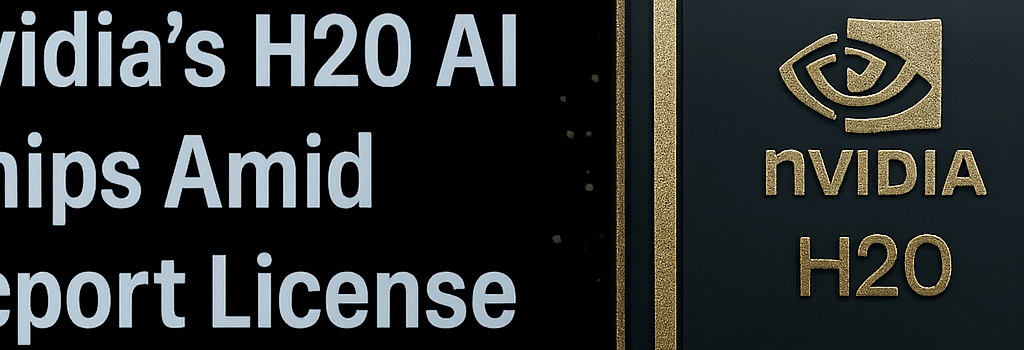Chinese Tech Giants Turn to Nvidia’s H20 AI Chips Amid Export License Approval

Updated August 20, 2025 — Nvidia is poised to restart shipments of its H20 data-center GPUs to mainland China within weeks, following assurances from the U.S. government that export licenses will be granted imminently. As Chinese cloud providers and internet conglomerates rush to secure capacity for generative AI workloads, experts warn this surge will reshape global supply chains and intensify competition in AI infrastructure.
Background: From Export Ban to License Reprieve
In April 2022, the U.S. Commerce Department imposed stringent export controls on Nvidia’s most advanced GPUs, citing national security concerns over their potential military and surveillance applications. The policy forced Nvidia to write off $4.5 billion in unsold inventory and halt sales of its flagship A100 and H100 chips to China.
Following high‐level discussions between Nvidia CEO Jensen Huang and President Donald Trump in mid-2025, and subsequent dialogues with the Biden administration, the Commerce Department indicated that it will streamline license approvals for the H20 GPU series. Sources within the department told Reuters that licenses could be issued by early September, clearing the way for immediate shipments.
Technical Deep Dive: What Makes the H20 Tick?
- Architecture & Parallelism: The H20 is built on Nvidia’s Ampere architecture, featuring 128 streaming multiprocessors and 12,288 CUDA cores, enabling up to 1,500 teraFLOPS of mixed-precision AI performance.
- Memory Subsystem: Equipped with 64 GB of HBM2e memory operating at 3.2 Gbps per pin, the H20 delivers 1.6 TB/s of aggregate bandwidth, essential for large language model training and inference.
- Interconnect & Scaling: Nvidia’s proprietary NVLink 3.0 offers 600 GB/s bidirectional bandwidth between GPUs, while PCIe Gen5 support ensures rapid host-to-device transfers in heterogeneous data-center servers.
Market Response: Chinese Firms Place Massive Orders
Industry insiders report that tech heavyweights such as ByteDance, Tencent Cloud, Baidu AI Cloud, and Alibaba Cloud have submitted purchase orders amounting to over 100,000 H20 units combined. At an estimated list price of $13,000 per GPU, these orders could generate up to $1.3 billion in revenue for Nvidia in Q4 alone.
“China’s AI compute hunger is insatiable,” says Dr. Lin Wei, a senior analyst at Pacific Crest Capital. “Even constrained to the H20’s slightly reduced performance tier, local cloud providers see these GPUs as mission-critical for real-time language services, recommendation engines, and autonomous vehicle simulations.”
New Sections for Deeper Analysis
Impact on Global Supply Chains
- Manufacturing Strain: TSMC and Samsung’s foundries, responsible for Nvidia’s 5nm process nodes, are operating at near-full capacity. Increased H20 demand may exacerbate lead times for other high-end chips.
- Logistics & Tariffs: To comply with U.S. regulations, shipments will transit through designated ports with enhanced screening, potentially adding 10–14 days to delivery schedules.
- Secondary Markets: Gray-market brokers are already listing H20 cards at 20–30% premiums, reflecting acute shortages.
Navigating Export Controls: Strategies & Outlook
Legal experts note that companies must now integrate advanced compliance platforms to track chip provenance, end-user commitments, and usage reporting. Failure to do so risks violating EAR99 provisions, which carry civil penalties up to $300,000 per violation.
Comparative Analysis: H20 vs. Higher‐Tier GPUs
While the H20’s 1,500 FP16 teraFLOPS match many enterprise needs, the embargoed H100 and GH200 series offer up to 2,000 FP16 teraFLOPS plus integrated Grace CPU memory coherence. This gap underscores the limitations Chinese firms will face in cutting-edge AI research.
Expert Opinions & Future Prospects
According to Gartner’s latest AI Infrastructure Magic Quadrant, Nvidia leads the pack, but AMD and China’s own Biren Technology are closing in with custom accelerators. Over the next 12 months, expect to see:
- Increased R&D investment by Chinese startups to build domestic GPU alternatives.
- Collaborations between cloud providers and academic institutions to optimize large-scale training on H20 clusters.
- Potential fresh export control measures if dual-use concerns intensify.
Bottom Line: The imminent resumption of H20 shipments not only revitalizes Nvidia’s China business—previously $17 billion in FY2024 revenue—but also ignites fresh debates around technology sovereignty, supply-chain resilience, and the future of AI competition.